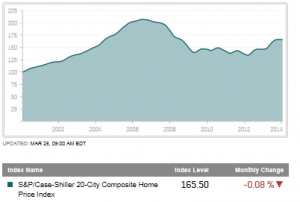After days of meetings, discussions and negotiating, the government finally came to a short-term resolution to allow the government shut-down to conclude and ensure default would not ensue. But this “my way or the highway” mentality on both sides of the political isle has damaged Washington’s credibility and confidence ratings among Americans. The lack of leadership in Washington and the “kicking the can down the road” ideology has affected several parts of the economy; both macro and micro in scope.
Reports released this Wednesday from the National Association of Home Builders (NAHB) showed a weakening in home builder confidence. In the market for new single family homes, the NAHB/Wells Fargo Housing Market Index (HMI) reflected a two point drop from an already downward revised report in September. NAHB Chief Economist David Crowe noted, “A spike in mortgage interest rates along with the paralysis in Washington that led to the government shutdown and uncertainty regarding the nation’s debt limit have caused builders and consumers to take pause. However, interest rates remain near historic lows and we don’t expect the level of rates to have a major impact on sales and starts going forward. Once this government impasse is resolved, we expect builder and consumer optimism will bounce back.”
 The NAHB describes the HMI as a an index that “gauges builder perceptions of current single-family home sales and sales expectations for the next six months as “good,” “fair” or “poor.” The survey also asks builders to rate traffic of prospective buyers as “high to very high,” “average” or “low to very low.” Scores from each component are then used to calculate a seasonally adjusted index where any number over 50 indicates that more builders view conditions as good than poor.” Current sales, sales expectations and traffic of prospective buyers all experienced a two point drop showing confidence is waning.
The NAHB describes the HMI as a an index that “gauges builder perceptions of current single-family home sales and sales expectations for the next six months as “good,” “fair” or “poor.” The survey also asks builders to rate traffic of prospective buyers as “high to very high,” “average” or “low to very low.” Scores from each component are then used to calculate a seasonally adjusted index where any number over 50 indicates that more builders view conditions as good than poor.” Current sales, sales expectations and traffic of prospective buyers all experienced a two point drop showing confidence is waning.
It appears that home builders aren’t the only ones lacking confidence. Consumers are showing signs of caution in the midst of Washington’s uncertainty. Last week during the partial shut-down, mortgage applications for government mortgage products dropped to a six-year low according the Mortgage Bankers Association (MBA). Mortgage applications to purchase a home declined by 5%. “The government shutdown had a notable impact on the mortgage market last week. Purchase applications for government programs dropped by more than 7 percent over the week to their lowest level since December 2007, and the government share of purchase applications dropped to its lowest level in almost three years. FHA lenders with delegated authority have been able to continue, but those that rely on the regional homeownership centers have not. Additionally, HUD staff at headquarters are generally furloughed and not able to answer questions,” said Mike Fratantoni, MBA’s vice president of research and economics.
It will no doubt take time to re-instill confidence that the American people had in their government’s elected officials. The negative impact of these past few weeks might haunt the economy and consumers for some time.
For information on effective ways to manage institutional and individual portfolios nationwide, or to shop for real estate visit First Preston HT. Like us on Facebook. Follow us on Twitter.
Sources: http://www.nahb.org
http://www.mbaa.org/NewsandMedia/PressCenter/85948.htm
 Outside analysts also see this shift in the market place. Stephen East from research firm ISI Group commented, “We view it as the right move. Horton’s cost structure and operational experience at the entry level makes them one of the few builders that can do this profitably. Also, we are firmly convinced the first-time-buyer segment is getting access to more credit, which will lead to more demand for this low-entry level product.”
Outside analysts also see this shift in the market place. Stephen East from research firm ISI Group commented, “We view it as the right move. Horton’s cost structure and operational experience at the entry level makes them one of the few builders that can do this profitably. Also, we are firmly convinced the first-time-buyer segment is getting access to more credit, which will lead to more demand for this low-entry level product.”

 Demand for housing is still strong and expected to stay this way through the spring according to some analysts. The Conference Board, a nonprofit association of businesses, found the percentage of consumers who intend to buy a home within the next six months is the highest it has been since 2000. One reason for this rising demand is young people who are still facing a tough job market. A housing analyst with Moody’s Analytics predicts the economy will expand enough this year to enable these young people to move out of their parent’s home. While they may mostly rent, a decrease in vacancy rates should put upward pressure on rental prices prompting interested home buyers who currently rent to make a real estate purchase.
Demand for housing is still strong and expected to stay this way through the spring according to some analysts. The Conference Board, a nonprofit association of businesses, found the percentage of consumers who intend to buy a home within the next six months is the highest it has been since 2000. One reason for this rising demand is young people who are still facing a tough job market. A housing analyst with Moody’s Analytics predicts the economy will expand enough this year to enable these young people to move out of their parent’s home. While they may mostly rent, a decrease in vacancy rates should put upward pressure on rental prices prompting interested home buyers who currently rent to make a real estate purchase. Weak residential mortgage origination results for the fourth quarter were recorded by Wells Fargo and JP Morgan Chase. Therefore analysts expectations for 2014 are being revised downward. The Mortgage Bankers Association (MBA) lowered its mortgage origination projections for 2014 by $57 billion to $1.12 trillion. Mike Fratantoni, chief economist for MBA, commented, “Despite an economic outlook of steady growth and a recovering job market, mortgage applications have been decreasing—likely due to a combination of rising rates and regulatory implementation, specifically the new Qualified Mortgage Rule.” A large portion of the reduction is refinance applications which are now estimated to decrease 60 percent this year from last year.
Weak residential mortgage origination results for the fourth quarter were recorded by Wells Fargo and JP Morgan Chase. Therefore analysts expectations for 2014 are being revised downward. The Mortgage Bankers Association (MBA) lowered its mortgage origination projections for 2014 by $57 billion to $1.12 trillion. Mike Fratantoni, chief economist for MBA, commented, “Despite an economic outlook of steady growth and a recovering job market, mortgage applications have been decreasing—likely due to a combination of rising rates and regulatory implementation, specifically the new Qualified Mortgage Rule.” A large portion of the reduction is refinance applications which are now estimated to decrease 60 percent this year from last year.
 Homebuilder sentiment was recently reported to be weakening, but U.S. spending on construction isn’t being held back by this news. During the month of August, construction spending almost hit a 4-1/2 year high due to increases from both the private and public arenas, according to the Commerce Department. The increase was .6 percent when compared to the month of July. July’s figures were revised to a number more than double the original estimate. These positive numbers show that there’s hope for growth in the third quarter this year.
Homebuilder sentiment was recently reported to be weakening, but U.S. spending on construction isn’t being held back by this news. During the month of August, construction spending almost hit a 4-1/2 year high due to increases from both the private and public arenas, according to the Commerce Department. The increase was .6 percent when compared to the month of July. July’s figures were revised to a number more than double the original estimate. These positive numbers show that there’s hope for growth in the third quarter this year.